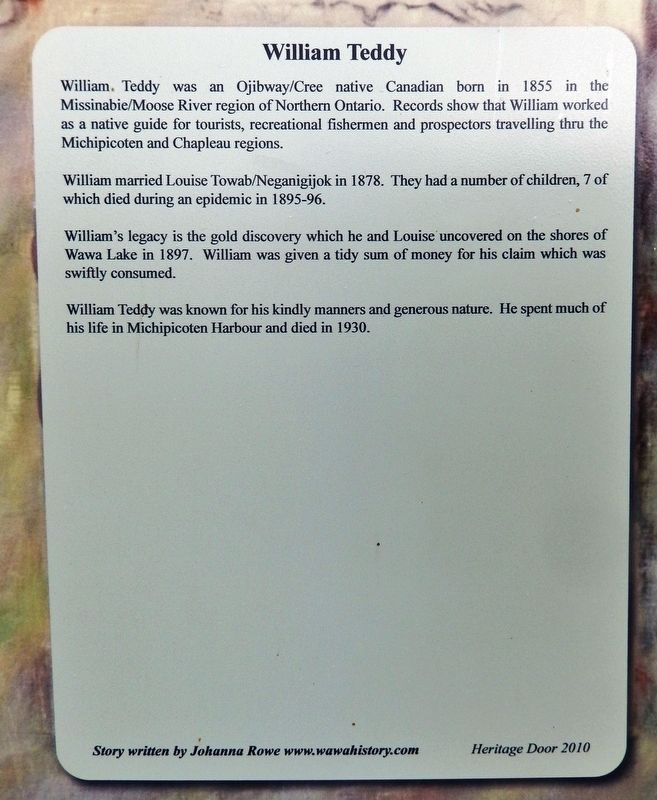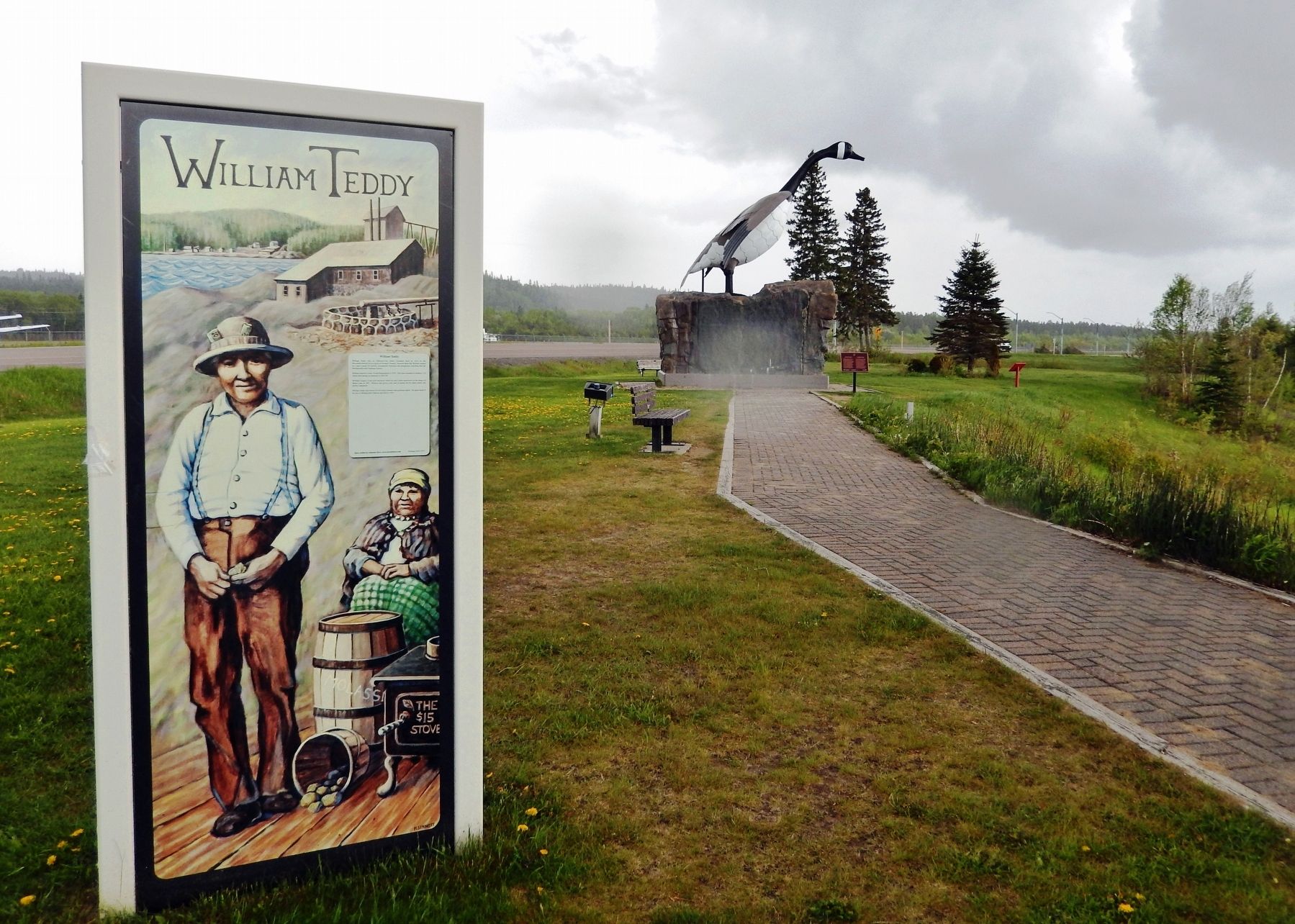Wawa in Algoma District, Ontario — Central Canada (North America)
William Teddy
William Teddy was an Ojibway/Cree native Canadian born in 1855 in the Missinabie/Moose River region of Northern Ontario. Records show that William worked as a native guide for tourists, recreational fishermen and prospectors travelling thru the Michipicoten and Chapleau regions.
William married Louise Towab/Neganigijok in 1878. They had a number of children, 7 of which died during an epidemic in 1895-96.
William's legacy is the gold discovery which he and Louise uncovered on the shores of Wawa Lake in 1897. William was given a tidy sum of money for his claim which was swiftly consumed.
William Teddy was known for his kindly manners and generous nature. He spent much of his life in Michipicoten Harbour and died in 1930.
Story written by Johanna Rowe www.wawahistory.com
Erected 2010 by Wawa Heritage Doors.
Topics. This historical marker is listed in these topic lists: Industry & Commerce • Native Americans • Settlements & Settlers. A significant historical year for this entry is 1897.
Location. 47° 58.429′ N, 84° 46.982′ W. Marker is in Wawa, Ontario, in Algoma District. Marker can be reached from Mission Road (Provincial Highway 101) just east of Trans-Canada Highway (Provincial Highway 17), on the left when traveling north. Marker is located at the Wawa Tourist Information Centre. Touch for map. Marker is at or near this postal address: 26 Mission Road, Wawa ON P0S 1K0, Canada. Touch for directions.
Other nearby markers. At least 8 other markers are within walking distance of this marker. Sir James Dunn (here, next to this marker); Louise (Niganigijigok) Towab (here, next to this marker); Lady Dunn (here, next to this marker); Alex Ross (a few steps from this marker); Keith Messenger (a few steps from this marker); Joe Ball (a few steps from this marker); Construction of the Trans-Canada Highway / La Construction de la Route Transcanadienne (within shouting distance of this marker); The Magpie River Valley (within shouting distance of this marker). Touch for a list and map of all markers in Wawa.
Also see . . .
1. The Algoma Gold Rush of 1897.
A picnic in 1897 on Mackey Point on scenic Wawa Lake was the staging area for Algoma’s first gold rush when Louise Towab and William Teddy uncovered a gold laced quartz vein. While the Klondike gold fever was still fresh in everyone’s blood, one thousand hopeful souls flocked to the tiny Michipicoten River Village and Hudsons’ Bay Company post. Visions of rich placer gold fired their imaginations. Every creek bed, river and stream were staked and panned. By September 1897, some 1,700 claims were staked. The area was proclaimed a mining division and the first Ontario Mining Recorder’s Office was set up at the abandoned Michipicoten HBCo. Post. Wawa City was surveyed and registered in 1899. The gold seekers soon discovered that there were no nuggets to be had. The most productive “gold mine” in the area was the local hotel and tavern known as the Balmoral Hotel, which sat where the Lakeview Hotel presides today.(Submitted on March 15, 2023, by Cosmos Mariner of Cape Canaveral, Florida.)
2. Wawa, Ontario.
Gold production slowed by 1906, but as mining technology improved, additional amounts began to be extracted from the area. Gold mining in the Wawa area prospered and receded several times in the 20th century, and it continues today. Notable producers include the Grace Mine (1902-1944), the Minto Mine (1929-1942), the Parkhill Mine (1902-1944), and the Renabie Mine (1920-1991). The search for gold during the Michipicoten boom led to the unexpected discovery in 1897 of iron ore. Iron ore extraction has also been an important industry in the area.(Submitted on March 15, 2023, by Cosmos Mariner of Cape Canaveral, Florida.)
3. Wawa Heritage Doors - portals into our past!.
"Wawa's Heritage Doors are a truly creative and effective way to combine history and art in a visually attractive cultural display for both Wawa residents and visitors to enjoy!"(Submitted on March 15, 2023, by Cosmos Mariner of Cape Canaveral, Florida.)
Credits. This page was last revised on March 16, 2023. It was originally submitted on March 14, 2023, by Cosmos Mariner of Cape Canaveral, Florida. This page has been viewed 65 times since then and 10 times this year. Photos: 1, 2. submitted on March 15, 2023, by Cosmos Mariner of Cape Canaveral, Florida.

